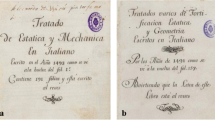Abstract
At the conclusion of his Epistula de magnete of 1269, Petrus Peregrinus de Maricourt described the construction of a continually moving toothed wheel that is powered by a magnet. The effectiveness of the device is enhanced by a small rounded weight made of brass or silver that is located between two of the theeth. According to the inventor, this metallic ball “seeks the center of the earth in virtue of its own weight, thereby aiding the motion of the teeth.”
In the secondary literature and in nearly all translations and reprints of the Peregrinus letter, this perpetuum mobile is illustrated by a picture that stems from the printed edition published by Achilles Gasser in 1558. This drawing is in evident contradiction with the text, and it is different from a variety of drawings of the same device that can be found in the manuscripts.
In this paper, the different drawings of Petrus’ machine are compared to the text as it is given in the recently published critical edition of the Peregrinus letter by Loris Sturlese (1995). With reference to other medieval perpetua mobilia, it is shown how the surviving illustrations of this construction must be slightly modified in order to represent a perpetual motion that is in accordance with the text and with the physical ideas of the 13th century.
Similar content being viewed by others
Literatur
Balmer, Heinz: Beiträge zur Geschichte der Erkenntnis des Erdmagnetismus. Veröffentlichungen der Schweizerischen Gesellschaft für Geschichte der Medizin und der Naturwissenschaften XX. Sauerländer: Aarau 1956.
Bertelli, Timoteo: „Sulla epistola di Pietro Peregrino di Maricourt e sopra alcuni trovati e teorie magnetiche del secolo XIII. Memoria seconda“. Bulletino di bibliografia e di storia delle scienze matematiche e fisiche, 1 (1868), S. 65–89.
Bertelli, Timoteo: „Intorno a due codici vaticani della Epistola de magnete di Pietro Peregrino di Maricourt ed alle prime osservazioni della declinazione magnetica“. Bulletino di bibliografia e di storia delle scienze matematiche e fisiche, 4 (1871), S. 303–331.
Daumas, Maurice: Histoire générale des techniques 1. Des origines au XVe siècle. Presses Universitaires de France: Paris 1962.
Dijksterhuis, Eduard Jan: Die Mechanisierung des Weltbildes. Springer: Göttingen u.a. 1956.
Gasser, Achilles (Hrsg.): Petri Peregrini Maricurtensis De Magnete, seu Rota perpetui motus, libellus, [...] per Achillem P. Gasserum nunc primum promulgatus. Augsburg 1558.
Grant, Edward: „Peter Peregrinus“. Dictionary of Scientific Biography. Vol. X, New York: Scribner 1974, S. 537.
Hahnloser, Hans R.: Villard de Honnecourt. Kritische Gesamtausgabe des Bauhüttenbuchs ms. Fr. 19093 der Pariser Nationalbibliothek. 2. Aufl., Akademische Druck- und Verlagsanstalt: Graz 1972.
Hellmann, Gustav (Hrsg.): Rara magnetica 1269–1599. Neudrucke von Schriften und Karten über Meteorologie und Erdmagnetismus 10. Asher: Berlin 1898.
Klemm, Friedrich: Perpetuum mobile. Ein «unmöglicher» Menschheitstraum. Harenberg: Dortmund 1983.
Libri, Guglielmo: Histoire des sciences mathématiques en Italie depuis la renaissance des lettres jusqu’à la fin du 17e siècle. T. II, Jules Renouard: Paris 1838.
Petrus Peregrinus de Maricourt: Opera, hrsg. von Loris Sturlese und Ron B. Thomson. Scuola Normale Superiore: Pisa 1995.
Radelet-de Grave, Patricia; Speiser, David: „Le De magnete de Pierre de Maricourt. Traduction et commentaire“. Revue d’histoire des sciences, 28 (1975), S. 193–234.
Sarton, Georges: „The first edition of Petrus Perigrinus [!], ‘De magnete’ (before 1520)“. Isis 37(1947), S. 178–179.
Schmeller, Hans: Beiträge zur Geschichte der Technik in der Antike und bei den Arabern. Mencke: Erlangen 1922.
Simonyi, Károly: Kulturgeschichte der Physik. Deutsch: Thun u.a. 1990.
Wessels, Gregor: „Manierismen der technischen Zeichnung. Zur Ikonographie des Perpetuum Mobile“. Erkenntnis, Erfindung, Konstruktion. Studien zur Bildgeschichte von Naturwissenschaften und Technik vom 16. bis zum 19. Jahrhundert, hrsg. v. Hans Holländer. Mann: Berlin 2000, S. 587–616.
Zilsel, Edgar: Die sozialen Ursprünge der neuzeitlichen Wissenschaft. Hrsg. von Wolfgang Krohn. Suhrkamp: Frankfurt (Main) 1976.
Author information
Authors and Affiliations
Additional information
Menso Folkerts zum 60. Geburtstag, in dankbarer Anerkennung seiner Verdienste um die Erschließung mittelalterlicher mathematischer und physikalischer Manuskripte.-Zweimal hatte ich die Gelegenheit, meine Überlegungen zum Perpetuum mobile des Petrus Peregrinus in Vorträgen vorzustellen. Ich danke Nicolaas Rupke für die Einladung zum Kolloquim des Instituts für Wissenschaftsgeschichte der Universität Göttingen und Torsten Gaulke für die Einladung zum „Dialogo“ der Abteilung Geschichte der Naturwissenschaften und Technik des Historischen Instituts der Universität Stuttgart.
Rights and permissions
About this article
Cite this article
Kleinert, A. Wie funktionierte das Perpetuum mobile des Petrus Peregrinus?. NTM N.S. 11, 155–170 (2003). https://doi.org/10.1007/s00048-003-0168-5
Issue Date:
DOI: https://doi.org/10.1007/s00048-003-0168-5




